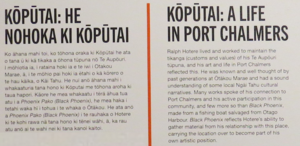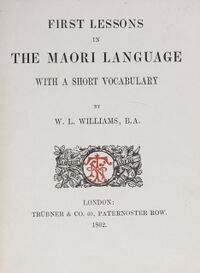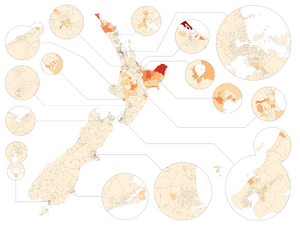لغة الماوري
| Māori | |
|---|---|
| Māori, Te reo Māori | |
| موطنها | New Zealand |
| المنطقة | Polynesia |
| العرق | Māori people |
الناطقون الأصليون | Some 50,000 people report that they speak the language well or very well;[1] 149,000 self-report some knowledge of the language.[2] |
| Latin (Māori alphabet) Māori Braille | |
| الوضع الرسمي | |
لغة رسمية في | |
| ينظمها | Māori Language Commission |
| أكواد اللغات | |
| ISO 639-2 | mao (B) mri (T) |
| ISO 639-2 | mao (B) mri (T) |
| ISO 639-3 | mri |
| Glottolog | maor1246 |
| Glottopedia | Maori[3] |
| Linguasphere | 39-CAQ-a |
| IETF | mi-NZ |
 | |
ماوري (Māori ؛ قالب:IPA-mi) هي لغة سكان نيوزيلندا الأصليين. وتعتبر جزء من لغة المالايو ,
يصل عدد متحدثيها لمئة وستين ألفا يتواجدون في نيوزيلندا وجزر كوك.
التاريخ
الأصول
التبويب اللغوي
|
|
التوزع الجغرافي
اللهجات

Biggs proposed that historically there were two major dialect groups, North Island and South Island, and that South Island Māori is extinct.[5] Biggs has analysed North Island Māori as comprising a western group and an eastern group with the boundary between them running pretty much along the island's north–south axis.[6]
لهجات الجزيرة الشمالية
In the southwest of the island, in the Whanganui and Taranaki regions, the phoneme ⟨h⟩ is a glottal stop and the phoneme ⟨wh⟩ is [ʔw]. This difference was the subject of considerable debate during the 1990s and 2000s over the then-proposed change of the name of the city Wanganui to Whanganui.
In Tūhoe and the Eastern Bay of Plenty (northeastern North Island) ⟨ng⟩ has merged with ⟨n⟩. In parts of the Far North, ⟨wh⟩ has merged with ⟨w⟩.[بحاجة لمصدر]
لهجات الجزيرة الجنوبية

التقويم
From missionary times, Māori adopted phonetic variants of the English names for the days of the week and the months of the year. Since about 1990, the Māori Language Commission has promoted new "traditional" sets. Its days of the week have no pre-European equivalent, but reflect the pre-Christian origins of the English names.[بحاجة لمصدر] The commission based the months of the year on those of the traditional Māori lunar calendar (maramataka).[7]
|
|
التأثير على إنگليزية نيوزيلندا
New Zealand English has gained many loanwords from Māori, mainly the names of birds, plants, fishes and places. For example, the kiwi, the national bird, takes its name from te reo. "Kia ora" (literally "be healthy") is a widely adopted greeting of Māori origin, with the intended meaning of "hello".[8] It can also mean "thank you", or signify agreement with a speaker at a meeting. The Māori greetings tēnā koe (to one person), tēnā kōrua (to two people) or tēnā koutou (to three or more people) are also widely used, as are farewells such as haere rā. The Māori phrase kia kaha, "be strong", is frequently encountered as an indication of moral support for someone starting a stressful undertaking or otherwise in a difficult situation. Many other words such as whānau (meaning "family") and kai (meaning "food") are also widely understood and used by New Zealanders. The Māori phrase Ka kite ano means 'until I see you again' is quite commonly used.
المترجمون أونلاين
Māori is available on Google Translate, Microsoft Translator and Yandex.Translate. Various Māori dictionaries exist on the website Glosbe. Another popular online dictionary is Māori Dictionary.[9]
انظر أيضاً
- Te Wiki o te Reo Māori (Māori Language Week)
ملاحظات
المراجع
- ^ خطأ استشهاد: وسم
<ref>غير صحيح؛ لا نص تم توفيره للمراجع المسماةtereoMaori - ^ خطأ استشهاد: وسم
<ref>غير صحيح؛ لا نص تم توفيره للمراجع المسماةEthnologue - ^ Glottopedia article on لغة الماوري.
- ^ Harlow 2006.
- ^ Biggs 1988.
- ^ Bauer 1997.
- ^ "Māori Orthographic Conventions". Te Taura Whiri i Te Reo Māori (Māori Language Commission). Retrieved 23 سبتمبر 2019.
- ^ Swarbrick, Nancy (5 سبتمبر 2013). "Manners and social behaviour". teara.govt.nz (in الإنجليزية). Te Ara: The Encyclopedia of New Zealand. Retrieved 21 فبراير 2018.
- ^ "Māori Dictionary". maoridictionary.co.nz.
المصادر
- Banks, Sir Joseph (1771). The Endeavour Journal of Sir Joseph Banks, Journal from 25 August 1768 – 12 July 1771. Project Gutenberg. Also available at Wikisource.
- Bauer, Winifred (1993). Maori. Routledge descriptive grammars. Routledge.
- Bauer, Winifred (1997). Reference Grammar of Māori. Auckland: Reed.
- Bauer, Winifred; Evans, Te Kareongawai; Parker, William (2001). Maori. Routledge descriptive grammars. Routledge.
- Biggs, Bruce (1988). "Towards the study of Maori dialects". In Harlow, Ray; Hooper, Robin (eds.). VICAL 1: Oceanic languages. Papers from the Fifth International Conference on Austronesian linguistics. Auckland, New Zealand. January 1988, Part I. Auckland. Linguistic Society of New Zealand.
- Biggs, Bruce (1994). "Does Māori have a closest relative?". In Sutton, Douglas G. (ed.). The Origins of the First New Zealanders. Auckland: Auckland University Press. pp. 96–105. ISBN 1-86940-098-4.
- Biggs, Bruce (1998). Let's Learn Māori. Auckland: Auckland University Press.
- Griffiths, George John; Goodall, Maarire (1980). Maori Dunedin. Dunedin: Otago Heritage Books.
- Clark, Ross (1994). "Moriori and Māori: The Linguistic Evidence". In Sutton, Douglas G. (ed.). The Origins of the First New Zealanders. Auckland: Auckland University Press. pp. 123–135. ISBN 1-86940-098-4.
- Harlow, Ray (1994). "Māori Dialectology and the Settlement of New Zealand". In Sutton, Douglas G. (ed.). The Origins of the First New Zealanders. Auckland: Auckland University Press. pp. 106–122. ISBN 1-86940-098-4.
- Harlow, Ray (1996). Maori. Languages of the world. LINCOM Europa. ISBN 9783895861208.
- Harlow, Ray (2006). Māori, A Linguistic Introduction. Cambridge University Press. p. 42. ISBN 978-1107407626.
- Harlow, Ray (2015). A Māori Reference Grammar. Wellington: Huia. ISBN 9781775502036.
- Goodall, Maarire; Griffiths, George J. (1980). Maori Dunedin. Dunedin: Otago Heritage Books.
وصلات خارجية
![]() تعريفات قاموسية في ويكاموس
تعريفات قاموسية في ويكاموس
![]() كتب من معرفة الكتب
كتب من معرفة الكتب
![]() اقتباسات من معرفة الاقتباس
اقتباسات من معرفة الاقتباس
![]() نصوص مصدرية من معرفة المصادر
نصوص مصدرية من معرفة المصادر
![]() صور و ملفات صوتية من كومونز
صور و ملفات صوتية من كومونز
![]() أخبار من معرفة الأخبار.
أخبار من معرفة الأخبار.
- Ngata Māori–English English–Māori Dictionary from Modern Teaching Aids; gives several options and shows use in phrases.
- Te Aka Māori-English, English-Māori Dictionary and Index, online version
- A Dictionary of the Maori Language by Herbert W. Williams, at the New Zealand Electronic Text Collection, Te Pūhikotuhi o Aotearoa
- Collection of historic Māori newspapers
- Maori Phonology
- maorilanguage.net Learn the basics of Māori Language with video tutorials
- Maori Language Week at NZHistory – includes a history of the Māori language, the Treaty of Waitangi Māori Language claim and 100 words every New Zealander should know
- Huia Publishers, catalogue includes Tirohia Kimihia the world's first Māori monolingual dictionary for learners
- Publications about Māori language from Te Puni Kōkiri, the Ministry of Māori Development
- Te Reo Maori word list A glossary of commonly used Māori words with English translation
- Materials on Maori are included in the open access Arthur Capell collections (AC1 and AC2) held by Paradisec.
- Articles containing Māori-language text
- Short description is different from Wikidata
- Articles with hatnote templates targeting a nonexistent page
- Missing redirects
- Use dmy dates from November 2017
- Language articles with speaker number undated
- Language articles with IETF language tag
- Languages with ISO 639-2 code
- Languages with ISO 639-1 code
- Language articles without reference field
- Pages with plain IPA
- Articles with unsourced statements from May 2021
- Articles with unsourced statements from August 2021
- Portal templates with default image
- Māori language
- Endangered Austronesian languages
- Polynesian languages
- Languages of New Zealand
- Tahitic languages
- لغات نيوزيلندا
- لغة ماورية


